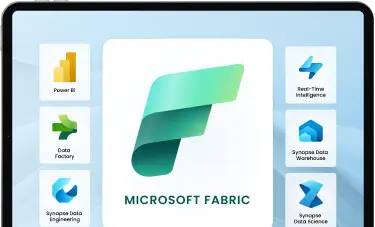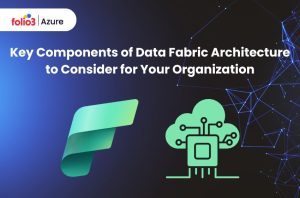Table of Contents
ToggleAccording to statistics from explodingtopics.com, approximately 402.74 million terabytes of data are created daily! But this is just an estimate because the amount of data generated every second is unimaginable and soaring at an ever-increasing rate.
Hence, in today’s world, where everything has become highly data-dependent, handling sensitive information securely is the top priority. As organizations scale up and embrace advanced technologies, secure data ingestion has become a necessity.
Data ingestion is collecting, transferring, and storing data that is gathered from various sources into a centralized system, such as a data warehouse or Lakehouse. But the catch is that this process can expose your organization to multiple security risks, such as data breaches, unauthorized access, and regulatory non-compliance.
Microsoft Fabric is an all-encompassing platform that empowers you with solid tools and security mechanisms to guarantee that your data ingestion processes are secure from end to end.
Whether you’re ingesting data from external systems, internal databases, or real-time streaming sources, Microsoft Fabric helps you minimize these risks while maintaining scalability.
This article will discuss how to guarantee secure data ingestion with Microsoft Fabric and the tools available.
Accelerate smart decisions with Microsoft Fabric's unified data and AI analytics.

The Need for Secure Data Ingestion
Successful data ingestion is the heart of present-day organizations, and data is their lifeblood. Data ingestion consists of moving raw data from multiple sources, such as databases, APIs, applications, or IoT devices, into centralized storage so that it is available for analysis, processing, and, finally, decision-making.
Ingesting data is the core component of business intelligence and analytics. It helps businesses extract meaningful information from raw data, make intelligent decisions, and increase their operational efficiency.
However, successful data ingestion is linked with significant risks, especially if the processes aren’t securely managed. Here are some of the primary risks associated with insecure data ingestion:
- Data Breaches: Unauthorized access to sensitive or confidential information can occur if data isn’t protected during ingestion.
- Non-compliance: Failure to adhere to regulatory standards such as GDPR, HIPAA, or SOC can result in costly fines and penalties and damage to the business’s reputation.
- Business Interruptions: Compromised data can cause operational failures in a business, affecting the continuity of business functions and resulting in significant financial losses.
- Data Integrity Issues: Unsecure ingestion processes may result in corrupted, incomplete, or inaccurate data, thus undermining the reliability of data analytics.
Adhering to compliance and regulatory standards during data handling is essential, but it is critical for organizations that operate in regulated industries such as healthcare, finance, and retail.
For example, the General Data Protection Regulation (GDPR) requires compliance with secure data handling and storage practices to protect personal information.
In the same way, the Health Insurance Portability and Accountability Act (HIPAA) in the U.S. makes it compulsory to protect health information during every stage of its lifecycle, including data ingestion.
With such high risks, ensuring secure data ingestion is not just a technical requirement; instead, it is a business compulsion. Microsoft Fabric comes with a wide variety of solid security features that give organizations the power to ingest data safely while guaranteeing strict compliance with industry standards and safety against threats.
Security Features in Microsoft Fabric for Data Ingestion
To help organizations handle the complexities of secure data ingestion, Microsoft Fabric provides various security features developed to protect data during the ingestion process. Below are the security features in Microsoft Fabric for data ingestion:
1. Data Encryption
One of the core and strong element of secure data ingestion is encryption. Microsoft Fabric uses data encryption during transit and at rest to protect sensitive information. Data is encrypted on the basis of industry-standard protocols.
Hence, this makes sure that even if it is somehow intercepted during ingestion, it cannot be accessed or deciphered by a third party without the correct encryption keys.
Encryption in Transit
Encryption during transit ensures that data being transferred from source systems to the data warehouse or data lake is encrypted, protecting it from interception during transmission.
Encryption at Rest
Once data reaches its destination, it remains encrypted, thus remaining safe from unauthorized access even when it’s stored.
By using encryption at these stages, Microsoft Fabric guarantees that your data remains secure from source to destination and is securely stored and ready for analysis.
2. Identity and Access Management
Another aspect of secure data ingestion is controlling who can access the data. Microsoft Fabric integrates easily with Azure Active Directory (AAD), which enables secure user authentication and gives role-based access control (RBAC).
This means that only authorized users can handle data ingestion processes. Thus, this eliminates the risk of insider threats or unauthorized access to sensitive data.
With Azure AD, administrators can define basic permissions according to the organizational roles and responsibilities. For example, only certain users can ingest data into warehouses, and others might have only view-only access. This warrants that access to sensitive data is limited and controlled.
3. Compliance and Governance
For businesses operating in highly regulated fields, it is essential to make sure that data ingestion procedures conform to legal requirements. Microsoft Fabric has built-in compliance tools that help you adhere to all regulatory requirements during data ingestion. These tools include the ability to:
- Define and apply data governance policies that guarantee that data is handled under regulations such as GDPR and HIPAA.
- Use auditing features to track actions taken during the ingestion process, providing complete transparency and accountability.
- Enforce data validation checks to check the integrity of data as it’s ingested, preventing errors and maintaining consistency.
By employing these tools, you can ensure that your organization’s data ingestion processes are secure and compliant with all the laws and standards.
4. Data Validation and Auditing
Data validation warrants that the data being ingested is accurate, complete, and uncorrupted. Microsoft Fabric comes with solid data validation features that check incoming data for errors prior to its ingestion into your data warehouse.
This prevents ingesting insufficient data, which can compromise data analytics and hamper decision-making later.
Moreover, its auditing features enable you to trace each action during the data ingestion process, from who accessed the data to when and how it was altered. This audit is important for maintaining data integrity and compliance, especially in industries that mandate strict compliance with regulations.
Data Ingestion Options
Microsoft Fabric provides various data ingestion options that match your company’s needs. The source data, complexity, and integration with other tools are all flexible regarding data ingestion. Here are a few important options:
1. Pipeline Copy Activity
This option works best for shifting large volumes of data from multiple sources (both on-premises and cloud) to a centralized data warehouse. It is a no-code solution and the best for users with minimal coding knowledge.
2. Dataflows Gen 2
It is a low-code option for business analysts or data engineers. Dataflows let you ingest and transform data from various sources using a visual interface. Thus simplifying the process for professionals who are not developers.
3. Apache Spark
Apache Spark is intended for complex data ingestion operations, it lets you write custom code (in languages such as Python, Scala, or R) for large-scale data processing and ingestion. It provides high scalability and performance, making it suitable for handling massive datasets.
4. Ingest data using Data Pipelines
Data pipelines automate data ingestion and transformation process. They can be modified to tackle batch or real-time data ingestion. Thus, making them highly flexible for a variety of use cases.
5. Ingest data using Transact-SQL:
If your organization prefers SQL-based ingestion, Microsoft Fabric supports data ingestion using Transact-SQL, letting you use SQL scripts for executing complex data operations.
Criteria to Decide Which Data Ingestion Tool to Use
Selecting the most appropriate data ingestion tool is dependent on multiple factors. Take into account the following criteria when deciding which option will work best for your organization:
- Data Volume: For organizations that manage massive datasets, Apache Spark or Pipeline Copy Activity are recommended as they can easily manage high data volumes.
- Transformation Needs: If your data needs major transformation, tools like Dataflows or Spark are recommended because they provide advanced transformation capabilities.
- Developer Expertise: Teams that have low coding knowledge may opt for no-code or low-code options like Dataflows Gen 2 or Pipeline Copy Activity. However, Spark or Transact-SQL gives greater control and flexibility for expert users.
- Real-time vs. Batch Processing: If you need real-time data ingestion, you may opt to use data pipelines that can handle streaming data, while batch ingestion can be managed through tools like Pipeline Copy Activity.
Conclusion
Ensuring secure data ingestion processes is the foremost priority for every organization that has to handle sensitive or highly regulated data. Microsoft Fabric provides a complete set of tools and strong security features that are developed exclusively to safeguard your data from when it is ingested until it reaches its destination.
Microsoft Fabric provides all the features needed to ensure safe data ingestion, regardless of your concerns about encryption, access control, compliance, or data validation.
Using the best data ingestion options and tools guarantees that your organization’s data is secure and always complies with industry standards. Thus, if you’re ready to implement secure data ingestion with Microsoft Fabric, explore Azure’s wide range of tools to support your data management and analytics.
Visit our Microsoft Fabric services page to start with secure and smooth data ingestion processes that are ready to tackle any security risks and compliance challenges down the line!


